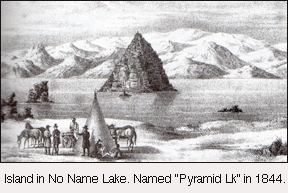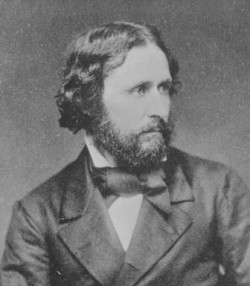Who discovered Lake Tahoe?
 February 14, 1844 — Lt. John C. Frémont is the first European to discover Lake Tahoe in the US today.
February 14, 1844 — Lt. John C. Frémont is the first European to discover Lake Tahoe in the US today.
But John Calhoun Johnson, founder of “Johnson’s Cutoff” (now U.S. Route 50), was likely the first white man to see Meeks Bay and from a peak above the lake he named Fallen Leaf Lake after his Indian guide.
His first job in the west was in the government service, carrying the mail on snowshoes from Placervilleto Nevada City, during which time he named the lake “Lake Bigler” in honor of California’s third governor John Bigler.
In 1853 William Eddy, the surveyor general of California, identified the lake as Lake Bigler. During the Civil War, Union advocates objected to the name, because Bigler was an ardent secessionist. Due to this, the U.S. Department of the Interior introduced the name Tahoe in 1862. Both names were in use: the legislature passed legislation declaring the official name to be Lake Bigler in 1870, while to most surveys and the general public it was known as Lake Tahoe.
The lake didn’t receive its official and final designation as Lake Tahoe until 1945.
Upon discovery of gold in the South Fork of the American River in 1848, thousands of gold seekers going west passed near the basin on their way to the gold fields. European civilization first made its mark in the Lake Tahoe basin with the 1858 discovery of the Comstock Lode, a silver deposit just 15 miles (24 km) to the east in Virginia City, Nevada.
From 1858 until about 1890, logging in the basin supplied large timbers to shore up the underground workings of the Comstock mines. The logging was so extensive that loggers cut down almost all of the native forest.
 Who was John Fremont? An American military officer, explorer, and politician, Fremont (January 21, 1813 – July 13, 1890) became the first candidate of the anti-slavery Republican Party for the office of President of the United States. During the 1840s, when he led four expeditions into the American West, that era’s penny press and admiring historians accorded Frémont the sobriquet The Pathfinder.
Who was John Fremont? An American military officer, explorer, and politician, Fremont (January 21, 1813 – July 13, 1890) became the first candidate of the anti-slavery Republican Party for the office of President of the United States. During the 1840s, when he led four expeditions into the American West, that era’s penny press and admiring historians accorded Frémont the sobriquet The Pathfinder.
During the Mexican–American War, he was a major in the U.S. Army, took control of California from the Bear Flag Republic in 1846. Frémont then proclaimed himself military Governor of California; however, for that he was convicted in court martial for mutiny and insubordination.
Historians portray Frémont as controversial, impetuous, and contradictory. Some scholars regard him as a military hero of significant accomplishment, while others view him as a failure who repeatedly defeated his own best purposes. The keys to Frémont’s character and personality may lie in his being born illegitimately, his ambitious drive for success, self-justification, and passive-aggressive behavior.
Sources
Words of Wisdom
To breathe the same air as the angels, you must go to Tahoe.





